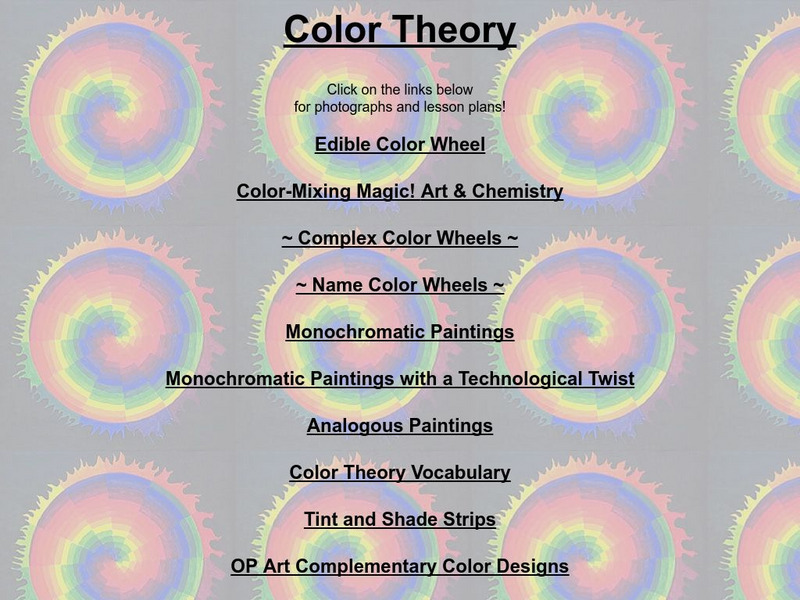Curated OER
Animal Invasion
Middle schoolers research and illustrate the natural habitats and evolution of giraffes and other animals imported into ancient Rome. They draw a map of Europe, North Africa, and West Asia and draw the animals from each region in their...
Curated OER
The Moving Continents from Pangaea to the Future
Eighth graders examine how the movements of the Earth contribute to fossil distribution. In this fossils lesson students make maps of the placement of the continents.
Curated OER
How We Perceive Movement, Depth and Illusions
Middle schoolers examine how depth perception works through a class experiment. They design and perform their own experiment that investigates visual illusions.
Curated OER
Heat and Light Come From Various Sources
First graders study heat and light and how they come from various sources. They list sources of heat and light and identify the different energy sources as heat, light, or both heat and light.
Curated OER
Photographic Diversity
Pupils explore photographic media. In this visual arts lesson, students sort postcard photographs into categories they devise. Pupils then learn to use cameras and darkrooms to that they may shoot their own photographs that belong in the...
Curated OER
Demystifying Stereotypes and Understanding Contemporary Cultures
Fourth graders compare and contrast folk songs from different cultures. In this music lesson plan, 4th graders listen to and list the attributes of selected Japanese and American folk songs. Students discover the customs, foods, and...
Curated OER
How We See: The First Steps of Human Vision
Students notice how various images and colors update constantly as they are affected by factors such as distance, background and lighting. They also examine how optometrists developed a standard to evaluate eyesight.
Curated OER
How Does Climate Affect Your Environment?
Students access the Global Sun Temperature Project website and research the relationship between the location and climate of a participating school to its building structure. They consider how climate affects the type of structures...
Curated OER
Probability: the Study of Chance
Students experiment to determine if a game is fair, collect data, interpret data, display data, and state and apply the rule for probability. Students use a simple game for this experiment.
Curated OER
Can Bacteria Arise from Non-living Things?
Fourth graders, in groups, determine whether bacteria arises from non-living things,
Curated OER
Mystery Box
Fourth graders engage in a icebreaker activity that is meant to introduce curriculum areas at the beginning of the school year. The teacher prepares several different boxes filled with items that are to be studied during the year. Then...
Curated OER
Japanese Lacquerware Art Lesson
Students are introduced to the traditional form of lacquerware painting in Japan. Students imitate Japanese lacquerware techniques using paper plates, gesso and tempera paints.
Curated OER
States of Matter
Learners categorize items into one of the three states of matter. They participate in a demonstration in which they represent particles of matter. Finally, they complete an experiment in which they "race" top see who can make acetone...
Curated OER
Tallahassee Project
Sixth graders gather information from technological sources such as TV, radio, and Internet as well as from newspapers and maps and produce a final printed report. They use the data to create a spreadsheet and read a Florida state...
Curated OER
Using several learning modalities to teach about the Periodic Table.
Students identify how to relate the position of an element in the periodic table to its atomic number and atomic mass. They identify how to use the periodic table to identify metals, semimetals, nonmetals, and halogens, and also,...
Curated OER
NOAA Research Project
Students research any topic relating to the National Oceanic and Atmospheric Administration (NOAA) research cruise that Mrs. Richards be participating in.
Other
Color Theory: Lesson Plans
This site was created by an art teacher and has several fun lesson plans that could be adapted to different grade levels. The activities are about color wheels, color theory, tints and shades, and several other subjects.
National Gallery of Art
National Gallery of Art: Monet's Waterscapes
Students will learn the color theory and techniques that guided Claude Monet's impressionist painting and apply those techniques to the creation of their own works of art.
California State University
Warm Sun and Too Cool Moon
Basic color theory introduced in a creative way. Students gain understanding of warm and cool colors as they each choose a palette and paint a sun or a moon.
PBS
Pbs: Hans Hofmann for Teachers (Lesson Plans)
Go directly to the lesson plans developed as complements to the PBS documentary "Hans Hofmann: Artist/Teacher, Teacher Artist." These classroom resources were designed to explore the influential theories of the artist.
Other popular searches
- Kandinsky Color Theory
- Color Theory Projects
- 3 Color Theory
- Art Color Theory
- Additive Color Theory
- Quilting Color Theory
- Color Theory With Painting
- Josph Albers Color Theory
- Color Theory Lesson Plans
- Fall Autumn Color Theory
- Op Art Color Theory
- Color Theory K 1


















